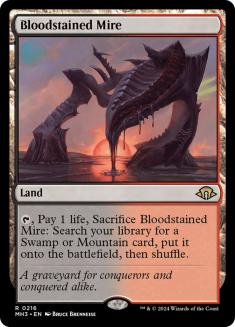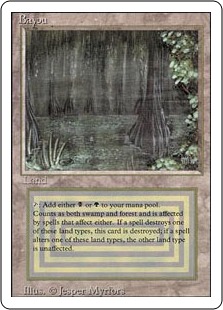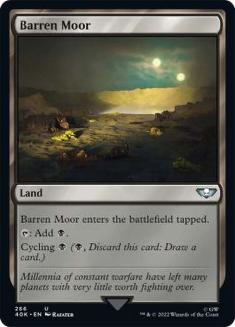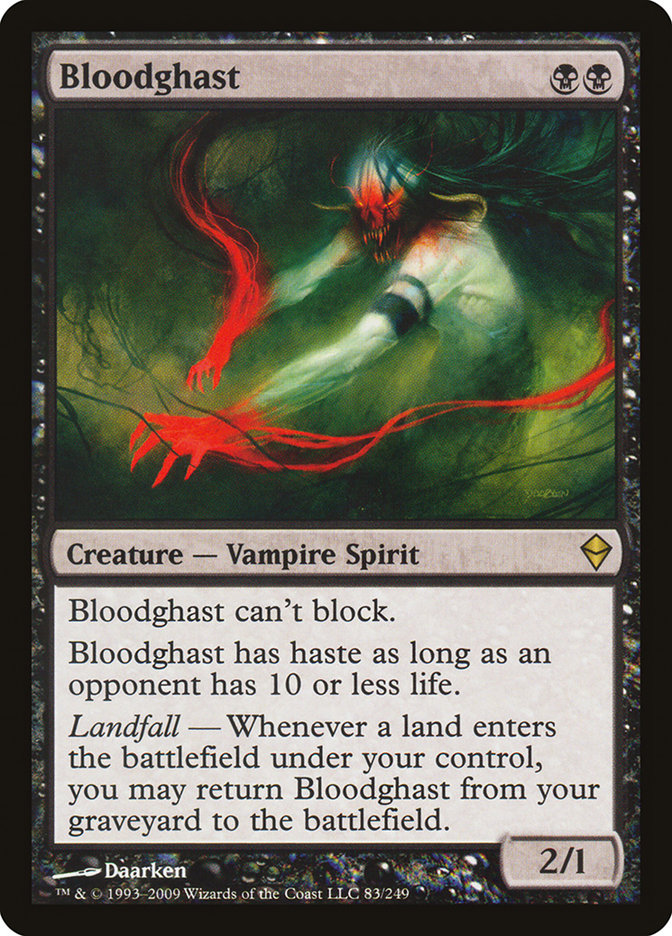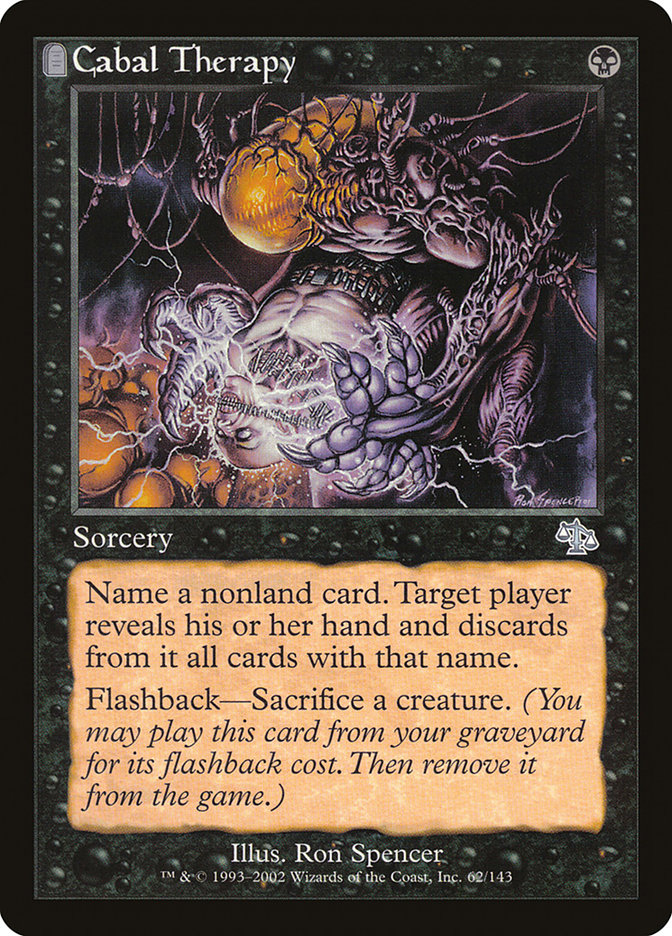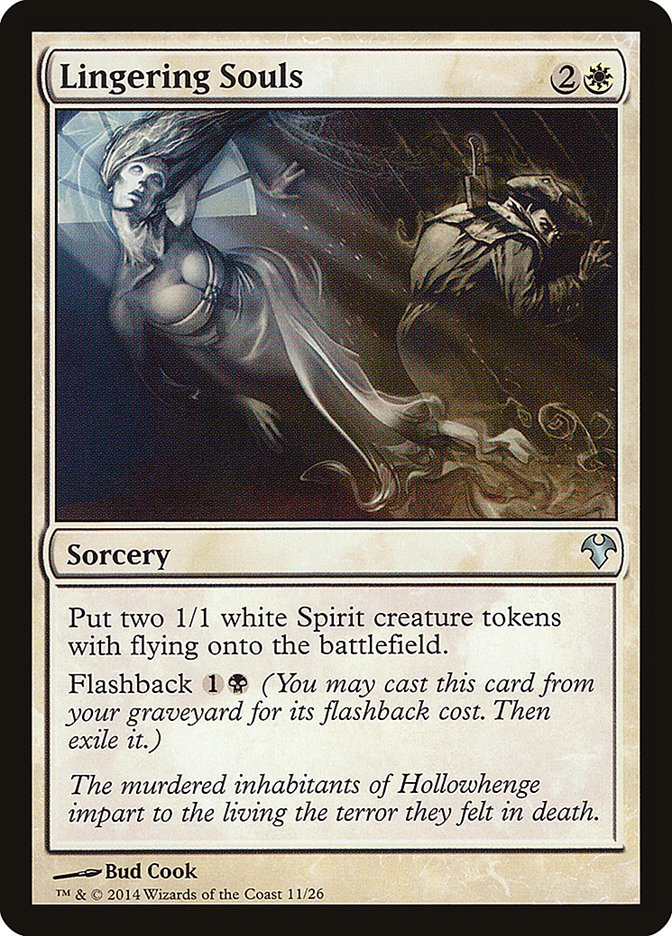Hello and welcome back to your favorite Legacy brewing show. Last time, it turned out that quite the number
among you have a pretty mean streak – not only did you ask for us to try to flood the Legacy format with Rats, when given the choice you even decided that
we should carefully plan to go after our opponents with biological weapons such as Smallpox! Well, your wishes are my commands in this series, so that’s
where we’ll be going today. As a reminder, here’s the concept list you voted for last time, in all its 63-card glory:
Creatures (8)
Lands (24)
Spells (31)

Alright, time to see what this can do!
A Different Process
This season’s Loam Pox approach differs from season one’s Goblin Welder and friends list in one very important aspect: The basic structure of the type of
deck we’re building has already been explored to quite an extent, and its core functionality – trading off resources to create a low resource game in which
our deck excels – is already partially defined by the inclusion of the card Smallpox as a defining feature. Essentially, what I’m saying is that this time
around we aren’t looking at as much of a brew, thus we don’t need to start the proving process as early, and we can therefore start testing our list a
little more freely then we did with last year’s brews.
And this is what I did this time around – instead of two-fisting a couple of games to see if the deck would fundamentally work, I directly brought it to
some modest battle testing. I was lucky enough to have one of my local comrades provide me with a copy of the deck (thanks again, Michael!) – turns out I
don’t have a number of cards from the deck – to bring to one of our informal Legacy testing sessions.
Now, this particular testing session wasn’t about finding win-rates or other final steps in the deckbuilding process; it was about fundamentally
understanding some decks, seeing some brews in action. Basically what we were trying to do was to gather first impressions about different aspects of
different decks for different players. Essentially exactly the thing our candidate needed to go through next given that the deck’s fundamental plan wasn’t
in question anymore.
All that being said, this type of first step testing is still about the deck itself, not its matchups. What you want to look out for isn’t how often you
win; that doesn’t matter yet. What we’re interested in are inefficiencies (and particularly strong synergies) in our brew. We want to figure out which
elements of the decks already do well, which cards or synergies either don’t pull their weight or aren’t supported enough to reach their full potential,
which specific holes are readily apparent and need fixing and which elements appear particularly strong in the rough draft.
I played the Loam Pox brew against a nice variety of decks that night – a slightly unusual EsperBlade list, Infect, a Mono-Black combo reanimator deck and
a japanese mono-brown version of 12-Post (not to be confused with MUD). Keep in mind though this still wasn’t about matchups, but about gathering
experience and first impressions. After playing a number of games, I took stock of what I learned about our deck and engaged in the first rough steps of
rearranging things.
The First Bout
I rapidly learned about a couple of simple structural issues. First and foremost, I realized I had forgotten one important tool for a deck wielding Life
from the Loam, fetchlands, and Cabal Therapy: Dryad Arbor. Even in those few games, wanting access to a random body in exchange for an extra fetchland came
up multiple times. I’d go so far as to call not having that Dryad Arbor in there in the first place an obvious oversight.
I also realized that, in spite of not having blue cantrips and being at 63 cards, the deck seemed to have too many mana sources at 24 lands (not counting
Dark Depths) plus four Mox Diamond. Both Life from the Loam and Grisly Salvage were most effective at helping you hit your land drops and drawing purely
mana source lands off the top after the third or fourth was very bad as a result.
This fed into a secondary problem: Loaming every turn wasn’t good enough because it wouldn’t really move you towards high-impact action. Sure, you’d have
access to a ton of lands, but as long as you couldn’t Wasteland-lock the opponent, Loaming didn’t really impact the game too much and didn’t dredge rapidly
enough to reveal sufficient graveyard tools to make that a workable gameplan.
The solution to this somewhat presents itself when you know a minimum about Loam decks in general: cycling lands. Cycling lands are awesome to Loam back,
feed Mox Diamond just as well as normal lands, and enable you to Loam more aggressively because you still get actual draw steps if you want them (and
mass-Loaming if you don’t). These are the first tweaks I made:
Out:
In:
Basically we have less reliable mana sources (that still serve in a pinch). The optimal configuration of lands to remove might be different but this should
serve as a reasonable upgrade for now if it still leaves the deck with the mana to operate.
Second Bout
I played the next couple of matches with this modified list and instantly was much happier with the deck’s mana flow. I used the cycling lands as mana
sources from time to time but could usually time it in such a way that the taplands were played during turns where I didn’t need the mana and/or mainly
wanted a land I wouldn’t mind sacrificing to that Smallpox of mine. The first batch of fixes seemed to be working out roughly like I’d hoped they would.
Now with a more smoothly flowing deck, I finally had a chance to see the deck put its tools into action unhampered by the constant lack of business I’d
been dealing with before – and I rapidly realized something else that wasn’t working out as I had hoped it would: The Bloodghast + Cabal Therapy package.
The biggest problem with the package was Bloodghast itself. The card simply isn’t very good when you draw it and have to naturally cast it (it’s a 2/1 that
can’t block for BB after all).That meant I’d have pretty terrible cards in hand a significant amount of the time. Now, that might still have been worth it
if Bloodghast had proven awesome in the roles I expected it to fill when brewing up the list – as a recursive threat with strong Cabal Therapy synergy.
Sadly, as it turned out, Cabal Therapy wasn’t actually too great in the deck. Hitting blind is an art, admittedly, but it’s much easier to do when you play
something like Storm where you care about a very limited class of spells and much more difficult when you’re generally trying to run your opponent out of
resources (because missing is suddenly very bad, while in Storm it just means they can’t stop you anyway). Combine that with the deck’s low creature count
and Cabal Therapy had a tendency to play out like a non-cantripping Peek a lot of the time. I’d cast it early (because you can’t sit around and let your
opponent do whatever they want to in Legacy) and miss, and I’d only be able to flash it back three or four turns later after finally hitting a Bloodghast –
at which point I once again wouldn’t have any idea as to what was in my opponent’s hand. A less than ideal way for things to play out for sure.
Bloodghast was also weak in its role as a secondary finisher. A 2/1 simply isn’t that much of a threat, especially in a deck like this that really doesn’t
have too many aggressive elements and is more interested in grinding things out. If Bloodghast could block it’d have been awesome, but it appears WotC
designed it this way on purpose, and I can see where that kind of gameplay would be a problem in general.
At this point I was reasonably sure these would need to go:
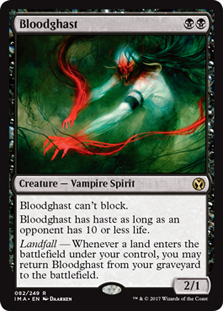




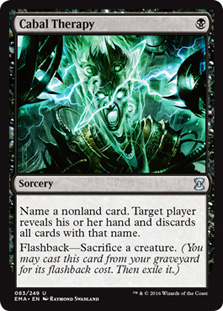



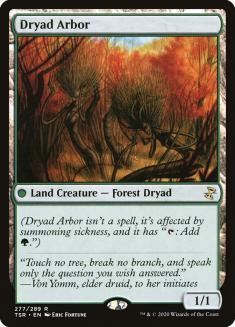

The question was, what to replace them with. Conveniently, there was another thing I was relatively unhappy with: how late the deck tended to start with
the business of actually getting ahead. Yes, the Life from the Loam engine I’d eventually hit between draw steps and Grisly Salvage would
generally give me some nice tools to take over the lategame. However, I had often interacted so little with my opponent’s earlygame and set up that I was
too far behind to pull back in time. The deck also was fully reliant on Loam to create real advantages. What I really was looking for was a disruptive
piece that could be cast early in the game and that would also further the whole grind it out plan better than Cabal Therapy had turned out to do. Sounds
like a job for my favorite Fallen Empires common!
Yes, it’s Hymn to Tourach. The card just does exactly what this deck wants to do (create cardboard advantage and a low resource environment), it is cheap
and it is disruptive. I know, Hymn is good in a heavy black deck. Shocking. I started out without it to give the Bloodghast + Cabal Therapy engine a shot,
but at some point you have to admit the newfangled idea just isn’t working and return to the time tested tool you know fits perfectly.
That’s one hole from removing the Therapy shenanigans filled, time to find a replacement way to win that works nicely from the graveyard (and, in the best
case scenario, can also be Salvaged into). At this point, I reflected on how my games had been playing out and finally accepted that Life from the Loam is
the actual heart of the deck. Yes, Pack Rat was a potent threat, but it’s hardly defining the deck’s gameplan and Grisly Salvage was a sweet tool – mainly
because it tended to dump a Loam, some sweet lands or a Raven’s Crime into the yard alongside whatever I Impulsed for. Neither defined the deck’s games as
much as Life from the Loam did, though.
However, one thing I had found myself looking at more and more during the games was the Dark Depths + Thespian Stage combo. Whenever I had access to one
half, it usually looked like a safe bet that I could hit my opponent with a 20/20 GerryT Avatar somehow if I managed to find the second half of the combo –
which rarely happened, unsurprisingly given that I only ran single copies of either. Now that I was planning to run disruption that worked independently of
other cards available to me, the way to compensate for the lack of Bloodghast beatdown could easily be to just focus more on the combo. So this is the next
change I made, going to 62 cards:
Out:











In:
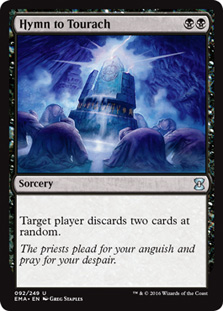



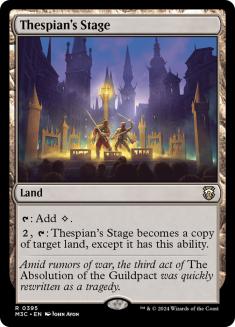

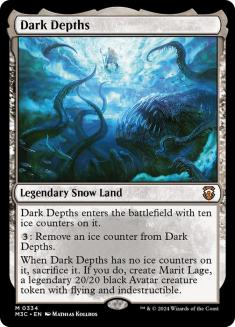


I played some more games with this and ended up much happier with the deck as a whole. Hymn did what Hymn does and the large amount of combo pieces usually
gave me a chance to set Marit Lage free in a reasonable time frame. In short, this felt like a valid direction to move towards. I also realized I had hit
another turning point here. If I continued to work from this base, I would most likely end up with an even stronger focus on the Loam engine (more cycling
lands, possibly more Raven’s Crimes, possibly even Exploration, Maze of Ith, or Ghost Quarter). That isn’t necessarily the way the deck has to go, though.
Another Direction
Focusing on the Dark Depths package wasn’t the only thing to help the deck out I could come up with. In fact, there is one particular set up that might be
worth exploring and that sets in even before the Hymn to Tourach swap: a minor white splash for Lingering Souls to replace Bloodghast, and Liliana of the Veil to complement them.
Yes, Lingering Souls doesn’t come back ad infinitum. It still produces a nice load of bodies to chump block (Bloodghast big failing) and Flashback
Therapies with. Similarly, Liliana would give the deck a complete secondary gameplan by turning Life from the Loam into actual card advantage and helping
control the board. You’d grind much more like a midrange deck instead of something focused on a synergistic Loam package, to the point that it might even
be worth considering Knight of the Reliquary in spite of having Smallpox in our deck.
Additional Issues
Other than these ideas for reworking the deck itself to function more coherently, this first round of testing also revealed a number of problems to keep in
mind while continuing work on this deck. When testing, aside from checking where your deck isn’t working as intended, you need to be looking where you’re
weak. What follows is the list of issues that need to be addressed when further working on the deck and possible solutions I’d consider exploring first.
Big creatures are a huge problem, especially flying ones.
I lost a couple of games to opposing creatures just being too big for the deck to deal with. You actually have a limited amount of removal (just Smallpox
and Abrupt Decay, essentially) so some of the heavy defensive lifting has to be done by your creatures (hence the weakness of Bloodghast). Pack Rat is a
brilliant tool to do that – as long as you can manage to trade them somewhat efficiently. Wurmcoil Engine, Batterskull, and similar tools make that rather
impossible, forcing you into a position where you keep making Rats to chump block but use all your resources to stay afloat while your opponent is getting
ahead. Not a good place to be in. Having a Batterskull equipped to a flyer also turned out to be supremely problematic seeing how Pack Rats don’t fly.
Possible Solutions:
Maze of Ith, Innocent Blood, Liliana Of The Veil
There is no way to recur removal lategame, and Grisly Salvage can’t find removal
Between Dark Depths + Thespian Stage, Raven’s Crime and Life from the Loam, you’re already well-prepared to set up a kill in the lategame as often as it
proves necessary to do so. The one thing you aren’t able to do repeatedly, however, is to kill things. There is no way to re-access your removal; even when your engine is fully up and running, there’s nothing to make sure you don’t just die in the process. Similarly, Grisly Salvage gives a
pretty decent Impulse with a bonus impression when you’re looking for threats, mana, or Life from the Loam and has some shot at helping out with disrupting
the opponent thanks to Raven’s Crime, but it can never find removal. Changing that would be a big boost to the deck’s consistency.
Possible Solutions:
Maze of Ith, Eternal Witness, Shriekmaw (with that, Volrath’s Stronghold)
Our Curve is off
When playing the deck, you rapidly realize there is a limited amount to do with a single mana and an overload of two-drops (not helped by me moving into
Hymn to Tourach). While that sounds minor on first sight, it means you tend to have inefficient turns, leaving significant amounts of mana unspent over the
course of the game because you can’t fill out your odd-mana turns efficiently enough. The obvious solution to this is to include more one- and three-mana
plays, it’s just a matter of figuring out the right ones.
Some sample tools to fix the curve:
Inquisition of Kozilek, Barren Moor, Tranquil Thicket, Liliana Of The Veil, Lingering Souls
Another way to work around that is more mana acceleration. Mox Diamond helps with this issue by pushing a two-drop to turn 1 (compensating for the fact
that you’ll likely also only spend two of your three mana next turn), and adding more ways to accelerate your mana growth could easily work as a different
way to help with the issue, making Exploration another possible solution to this problem.
Smallpox feels weak against opponents with few creatures
The problem here is two-fold. First, you don’t really trade resources efficiently when they don’t have to sacrifice a creature to make up for you investing
the Smallpox, though Loam helps with this to a certain extent by compensating for the discard part. Second, the mana denial aspect of Smallpox tends to
matter too little. Most non-Delver decks today are built with the idea that their opponent will Wasteland them a time or two – in short, they usually have
a land or two to spare. Until you enter the Wasteland recursion phase of the game, however, you don’t really have additional tools to punish a land-light
state of the opponent, turning Smallpox from a signature play into something of rather minor impact. Not a great position to be in. This is a situation we
can accept under the assumption that most of our opponents will play creatures to Smallpox away, though it still argues we might want to support the mana
denial theme further.
Possible Solutions:
How To Progress
Well, that’s the current state of affairs concerning this years candidate in You Choose The Brew. I have a number of decent ideas in which our deck could
move, though they’ll likely push me further away from the traditional Loam Pox deck and closer to a disruptive G/B Loam deck that focuses on Dark Depths +
Thespian Stage and uses Pack Rat as a secondary beatdown plan to overwhelm spot removal.
I could also take a step back from my latest tested changes and explore the white splash and a more midrangy approach to Loam + Poxing our opponents,
though I have to honestly admit there’s also a shot the deck would move away from Smallpox itself during the tuning process, moving us closer and closer to
the Abzan Knight of the Reliquary list from episode two.
Finally, maybe at this point you’d like to take charge completely. It’s always possible that you feel we (well, I, really) are moving too far from the core
concept as you my dear audience see it and you’d like to take charge yourself and have me stop messing with the list (thereby ending this season’s run of
You Choose The Brew). That’s for you to decide!
As every time, the poll will stay open til next Sunday, cast your votes wisely!

